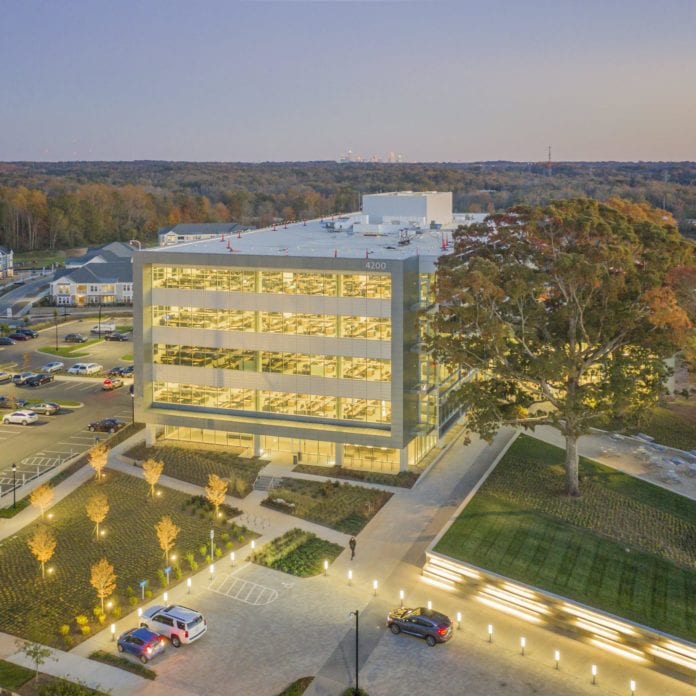The new Corning Optical Communications headquarters in Charlotte, North Carolina boasts a gleaming, modern exterior. But it may be even more modern on the inside, in its approach to technology and in particular, wireless connectivity.
“It’s really a vast departure from the way that network technology has been put into buildings for the last several decades,” said Brian Davis, global market development director of in-building networks at Corning Optical Communications.
The 180,000-square foot facility has six floors and a “wireless-first” approach to its network design. Three floors feature cellular connectivity provided by a distributed antenna system; three floors have cellular small cells, because Corning wanted to showcase both types of solutions. The building also has a robust Wi-Fi network throughout, and the fiber-and-power converged network backbone additionally supports an audio-visual network, sound masking and a security system, including parking lot cameras.
“We don’t drop a cable to every desk. Every desk doesn’t have its own port. We use and connect to the network very differently now than what we have in the past,” Davis said. In an open office environment such as new HQ offers, he continued, people often don’t spend the majority of their time at their desks. They are also using multiple mobile devices during formal and informal meetings. Instead of focusing on providing wired connectivity to static, individual workspaces, Davis said, the technology strategy is to deliver wireless bandwidth to many users and multiple devices, anywhere in the building.

From the start of the planning, Davis said, Corning knew that it wanted “a building that worked well with technology and integrated technology. But we needed it to work well with our people, too, so we spent more time effectively using technology than sitting there fighting with it.”
The solution at the center of Corning Optical’s business – optical fiber – also became the heart of its building’s connectivity. Corning used its own ActiFi converged cable, which combines fiber strands and copper for carrying power into a single cable. Collapsing everything into a single backbone, Davis said, enabled the building to be built with 70% fewer linear feet of cable than is typical. The building’s network runs out of a single, converged telecom room (although there is redundant external connection to the internet), which means that there isn’t a telecom closet on each floor – a cost savings of between $50,000-$75,000 per closet, Davis said. The capacity that comes with using fiber plus strong cellular and Wi-Fi connectivity also means that additional services and devices can be easily layered on top, he pointed out, noting that as Corning Optical considers its options for safer working conditions in response to the coronavirus pandemic, it can easily add connected thermal scanners or other IoT technologies to protect its employees. The converged ActiFi cable in conjunction with remote power units injecting power around the building also mean that the building is prepared for its power needs to scale. Power requirements are unlikely to come down, Davis said, and part of network planning involves considering both current and likely power needs in the near-term future
In addition to using its own fiber, small cell and DAS solutions, Corning Optical also leaned on its acquisition of Spidercloud to work around the most challenging aspect of indoor cellular: Getting a robust signal source to carry throughout the building. (Davis points out that, as a company that develops both wireless products and glass, Corning understands very well the qualities of low-emissivity glass, a notorious signal-killer.) SpiderCloud’s portfolio includes a baseband unit that connects to a carrier core network and provides a carrier-approved signal source with similar reliability to a carrier base station, without the long timelines and approvals involved.
In addition to savings in the building’s capital expense, Davis said, Corning’s approach also means that future upgrades will be less expensive. A generational change in Wi-Fi simply means replacing access points, because there’s already power and a high-capacity network to carry the traffic. While the building is currently equipped with 4G, Davis said, it is similarly 5G-ready in that it only needs to have new radios placed. He estimated that technology upgrades will cost half of what is typical, because no re-cabling will be required.
Davis also said that the question of whether to have a Wi-Fi or a cellular network in a modern building has a simple answer: Both.
“We see the need inside of buildings for wireless,” he said. “It’s not, ‘Is it going to be Wi-Fi or 5G?’ It’s not Wi-Fi 6 versus 5G, it’s Wi-Fi 6 and 5G. We see the need to have both inside of buildings. It’s important to have those different connectivity types.”
In much the same way, Davis urges people to challenge the status quo on how to plan and architect in-building networks. First, he says, start planning for technology integration early in the building process. “You can’t wait until the building is built to make those decisions, or you don’t get the savings,” he said. Second, “challenge the mindset of the way you’ve done things in the past, because we’ve got so many new things on the network now, and we use and connect so differently. [But] our mindset is still entrenched in the way that networks were put together in the early ’90s. We have to challenge that mindset and think differently about it.”
Looking for more insights on advanced in-building wireless networks? Register for RCR Wireless News’ upcoming webinar on things to know in indoor 5G network design and keep an eye out for the accompanying special report, to be published later this week.

